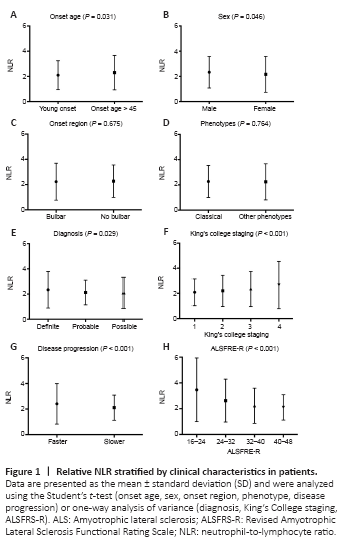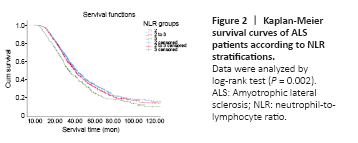神经退行性病
-
Figure 1|Relative NLR stratified by clinical characteristics in patients.

The demographic and clinical features of ALS patients are shown in Table 1. The patients were subdivided into three groups according to their NLR values: 544 patients (52.8%) were in Group 1 (NLR values < 2), 314 patients (30.5%) were in Group 2 (NLR values 2–3), and 172 patients (16.7%) were in Group 3 (NLR values > 3).There were significant differences between the three groups in sex, onset age, ALSFRS-R score, ALS progression rate, and percentage of early disease stage. Figure 1 shows the relationship between NLR and various clinical aspects of ALS. The onset age, sex, probability of an ALS diagnosis, King’s College staging, disease progression, and ALSFRS-R score were significantly related to NLR (all P < 0.05).
Figure 2|Kaplan-Meier survival curves of ALS patients according to NLR stratifications.

Upon the completion of follow-up studies, 677 patients (65.7%) had died, 353 patients (34.3%) were alive, and no patients were lost to follow-up. The mean survival time was 40.2 months. Considering all 1030 ALS patients, Kaplan-Meier analysis revealed that the survival time was significantly different among the three subgroups, stratified according to their NLRs (log-rank P = 0.002, Figure 2). Patients in Group 3 had worse outcomes. The survival time was significantly shorter in Group 3 compared with Group 1 (estimated median survival time: 32.0 months vs. 42.1 months, log-rank P < 0.001). The estimated median survival time was 42.0 months in Group 2, which was significantly longer than that of Group 3 (log-rank P = 0.008). The survival time between Groups 1 and 2 did not differ significantly (log-rank P = 0.551).